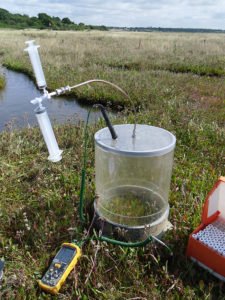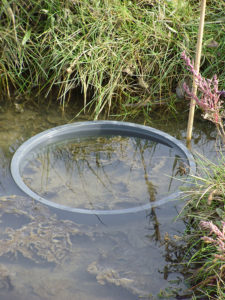The Redeker Lab at the University of York is leading a study that compares seasonal, climate-impacting behaviour between natural and human created (aka: realigned) salt marshes for four natural/realigned pairings in Essex. These sites include marshes that have recently been developed and those accidentally created over 100 years ago.
Trace gas fluxes, above-ground biomass, and a subset of sediment physical/chemical characteristics have been processed for the summer season. Early results suggest that human managed salt marshes have a different above-ground biodiversity, composition and trace gas flux signature than natural marshes, a result that appears to hold true for even the oldest marshes at 100+ years!
 To date we have completed the summer campaign and have recently begun sampling for the autumn season. We will continue sampling through this autumn, with further seasonal campaigns planned for 2015. Each campaign consists of ~100 trace gas flux measurements for a suite of gases that include greenhouse gases, ozone-depleting compounds, and aerosol forming compounds. Soil cores, paired to the trace gas flux measurements, will quantify microbial biodiversity and sediment physical and chemical characteristics. Above-ground biomass and biodiversity is also measured at each site where trace gas flux measurements have been taken. These plant and soil characteristics will be used to predict future global impacts from temperate salt marsh ecosystems, whether they are natural or man-made.
To date we have completed the summer campaign and have recently begun sampling for the autumn season. We will continue sampling through this autumn, with further seasonal campaigns planned for 2015. Each campaign consists of ~100 trace gas flux measurements for a suite of gases that include greenhouse gases, ozone-depleting compounds, and aerosol forming compounds. Soil cores, paired to the trace gas flux measurements, will quantify microbial biodiversity and sediment physical and chemical characteristics. Above-ground biomass and biodiversity is also measured at each site where trace gas flux measurements have been taken. These plant and soil characteristics will be used to predict future global impacts from temperate salt marsh ecosystems, whether they are natural or man-made.
 This collaborative research project began this summer with members of the University of Essex, Centre for Ecology and Hydrology Bangor and the University of York and has since expanded to include the Universities of Cambridge and several new members from the universities of York and Essex. This project furthers the defined CBESS objectives by extending seasonal datasets on trace gas fluxes, soil properties and above- and below-ground biodiversity for two of the natural salt marshes studied within the CBESS programme. The data collected in this programme may also be useful in identifying context-dependencies in biodiversity and ecosystem services, especially in combination with the larger datasets collected through the CBESS programme. Furthermore, we hope to develop an innovative, non-invasive tool to study in situ microbial populations through trace gas “fingerprints”.
This collaborative research project began this summer with members of the University of Essex, Centre for Ecology and Hydrology Bangor and the University of York and has since expanded to include the Universities of Cambridge and several new members from the universities of York and Essex. This project furthers the defined CBESS objectives by extending seasonal datasets on trace gas fluxes, soil properties and above- and below-ground biodiversity for two of the natural salt marshes studied within the CBESS programme. The data collected in this programme may also be useful in identifying context-dependencies in biodiversity and ecosystem services, especially in combination with the larger datasets collected through the CBESS programme. Furthermore, we hope to develop an innovative, non-invasive tool to study in situ microbial populations through trace gas “fingerprints”.
Kelly Redeker, University of York

